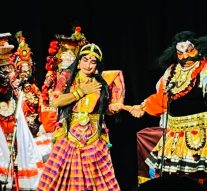Goa is abuzz with excitement as vintage bike and car owners, users, collectors and fans are decking […]

Draupadi lives on!
Uncategorized November 14, 2025By Prema Viswanathan
As a powerful ancient tale is re-enacted in ritual theatre, India’s conscience stands trial again
The humiliation of Draupadi in the court of Hastinapur remains one of the most searing episodes in the Mahabharata — a moment that refuses to fade, reverberating through the centuries, forcing each generation to confront its own questions of power, patriarchy, and justice.
Two weeks ago, at the National Gallery of Modern Art in Bengaluru, this timeless scene was retold with an intensity that left the audience shaken. Through the triple prism of Kerala’s Kathakali, Karnataka’s Yakshagana, and Tamil Nadu’s Therukoothu, three traditional forms of storytelling converged upon a single truth — that the outrage Draupadi faced is no relic of the past. Its embers still smoulder, even as cries for change gather momentum.
The three-day event — drawn from that apocalyptic moment in the Mahabharata — united established and emerging performers from three southern states, each bringing the pulse of their own tradition, yet speaking the same moral tongue: what becomes of a world where a woman’s dignity is bartered for power?
Kathakali’s sculptural gestures, Yakshagana’s thunderous oratory, Therukoothu’s earthy immediacy — together they transformed myth into mirror. What unfolded on stage was not pageantry, but reflection — India’s present gazing into the face of its past.
The concept, the brainchild of renowned artist Balan Nambiar, found theatrical form under the guidance of K.K. Gopalakrishnan, the dynamic director of the South Zone Cultural Centre, in collaboration with NGMA, under the aegis of the Ministry of Culture.
A Silence That Still Echoes
The audience sat transfixed as Draupadi, her voice trembling yet unbroken, demanded to know why her husbands — the self-proclaimed upholders of dharma — stood mute while she was humiliated before a hall of men. “Where are you, Krishna?” her cry resounded through the auditorium.
But it was the silence — the silence of spouses, elders, courtiers — that spoke loudest. It is a silence that still stalks our streets.
Just a week earlier, two Australian women cricketers were molested on the streets of Indore — a city that prides itself on culture and hospitality. The brazenness of the act, in a supposedly cosmopolitan space, during an international event, shocked many — yet for women in India, it was a story as old as time. From Delhi’s dark lanes to Goa’s beaches, from glass encased offices to dusty village squares, women continue to live Draupadi’s ordeal in a thousand forms: touched, taunted, threatened, violated — while a thousand modern Hastinapurs look away.
From Bhanwari Devi to Nirbhaya, from Soumya Viswanathan to Asifa Bano, the cycle of violence continues — unabated, unrepented.
The Goddess and the Working Woman
The irony is unbearable. We are a nation that worships goddesses, that celebrates Shakti in temple courtyards and Navaratri processions — yet turns away when that same Shakti, clothed in mortal skin, is defiled.
Draupadi’s disrobing becomes more than myth — it becomes metaphor. A national shame replayed in new guises each time the police delay, the courts falter, or society simply moves on.
Through Kathakali’s stylised anguish, Yakshagana’s rhetorical blaze, and Therukoothu’s raw directness, the NGMA performance revealed another layer: Draupadi’s question was not only about gender. It was about power — who wields it, who fears to lose it, and who must pay the price of that fear.
The court of Hastinapur was not merely patriarchal; it was political. Every man in that assembly weighed his silence against his stake — a kingdom, a reputation, an alliance, a disruption of the prevalent patriarchy. That silence was complicity. And it endures wherever fear outvotes conscience.
From Epic to Everyday
As the Therukoothu performer — radiant in costume, anklets ringing — broke into a raw lament, the audience felt the line between epic and everyday blurring.
“You strip me of my sari,” she cried, “but can you strip me of my spirit?”
The answer, echoing through millennia, was no.
For Draupadi stands not as victim, but as survivor, as defiance — the voice that shatters hypocrisy, the conscience of the Mahabharata, the woman who forces a civilisation to look at itself.
In an age when outrage burns briefly and dies with the news cycle, the performances reminded us that art holds memory longer than politics. Art abhors amnesia.
The Kathakali segment, with its slow, sculptural rhythm and deliberate stillness, its prolonged pauses allowing room for improvisation, its quivering eye, lip and hand movements, conveyed Draupadi’s inner storm more piercingly than any speech. Speaking to Kalamandalam Shivadas, who has been playing the role of Draupadi and other female protagonists in his 40 years of Kathakali performance (he was 14 when he first ascended the stage), I unravelled the emotional investment that a male artiste makes when enacting a powerful female character. “I have to empathise with Draupadi’s predicament, her anger and anguish becomes my own,” he revealed. The empathy was evident in the authenticity and humaneness he brought to his performance. Gender identities dissolved as one witnessed on stage the angst of a human being seeking justice from an oppressive patriarchal system.
Yakshagana’s booming percussion, flamboyant gestures and trenchant dialogue exposed the cowardice of those who silently watched the disrobing of Draupadi. And in Therukoothu’s open, democratic space, with characters wearing colourful, rustic costumes and ritualistic make-up, and pouring out their hearts in rustic dance and drama, the story returned to its truest home — the street — where Draupadi is no longer a queen, but every woman denied justice.
The Miracle and the Indictment
There is a terrible symmetry between Hastinapur and India today. Then, as now, morality wore a male face; protection was divine, not human.
Krishna’s miracle — the endless cloth that shields Draupadi — was both a blessing and an indictment. Why must the divine be summoned to mend human cruelty? Why must women depend on a saviour rather than law? Krishna’s miraculous protection of Draupadi — the endless fabric that saves her from shame — becomes symbolic of the resilience and inner strength that women are forced to summon in the absence of social or institutional support.
The questions linger. The police respond with platitudes, politicians with outrage, the media with a passing shudder — and life resumes its indifferent pace.
Draupadi’s disrobing becomes cyclical, its recurrence a measure of our collective failure to protect the vulnerable and provide justice to the oppressed.
The Question That Still Burns
The incandescent performances ended in ritual resolution — the punishment of the violator — but Draupadi’s call for justice outlasted the vengeance.
As the curtain fell, the audience rose in silence, as if words had lost their use. Outside, the night air throbbed with the fading echo of drums, and it seemed as though Draupadi herself had stepped out of the epic and into the present — walking beside the countless unnamed women who move through our streets each day: vulnerable, yet unbowed.
The story, retold through art, forces us to see what we choose to ignore. It confronts the conceit of a nation that calls itself modern yet kneels before ancient hierarchies of gender and power.
And it asks, still, with the same terrible clarity:
When will the silence of the righteous end?















